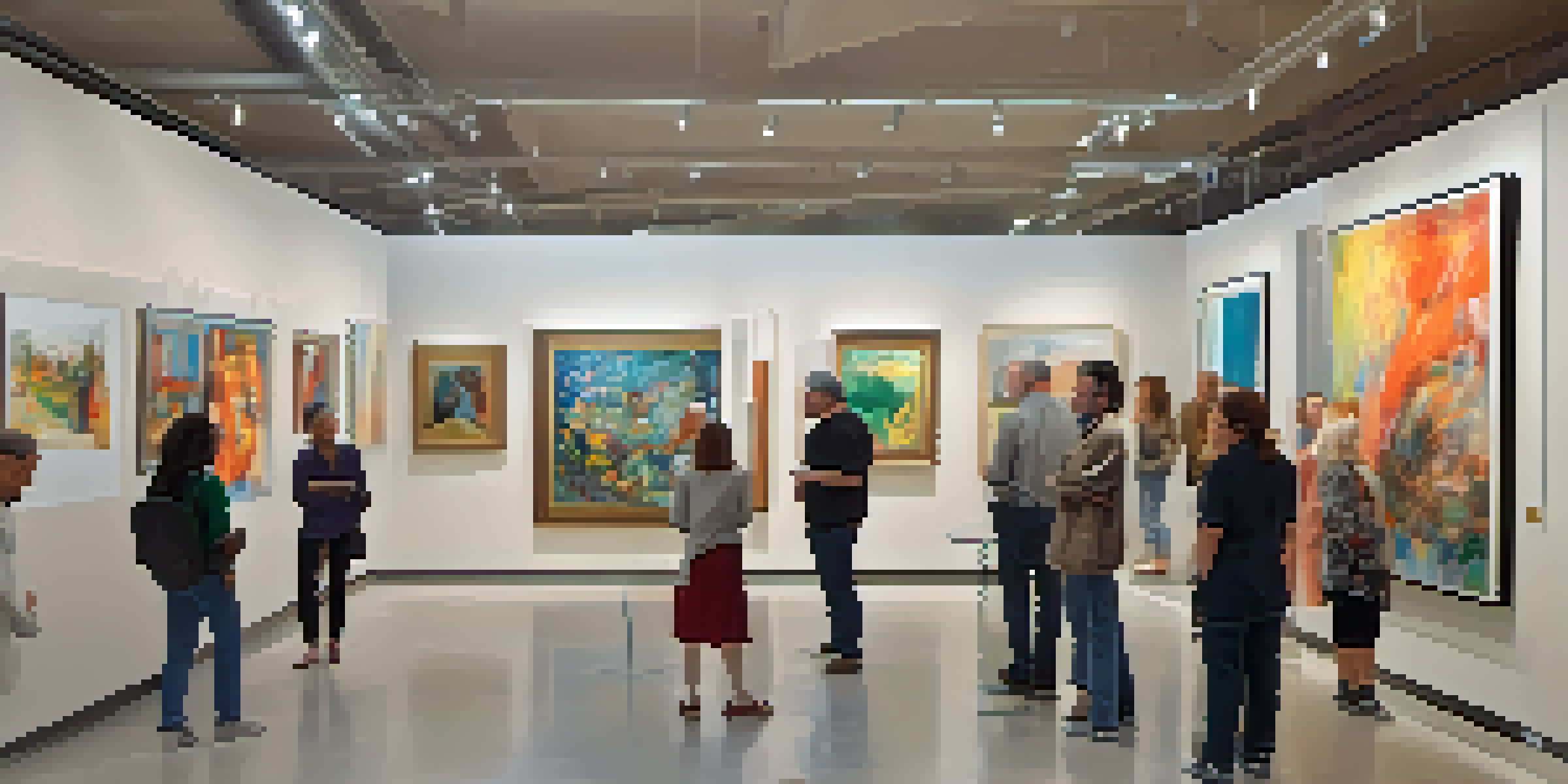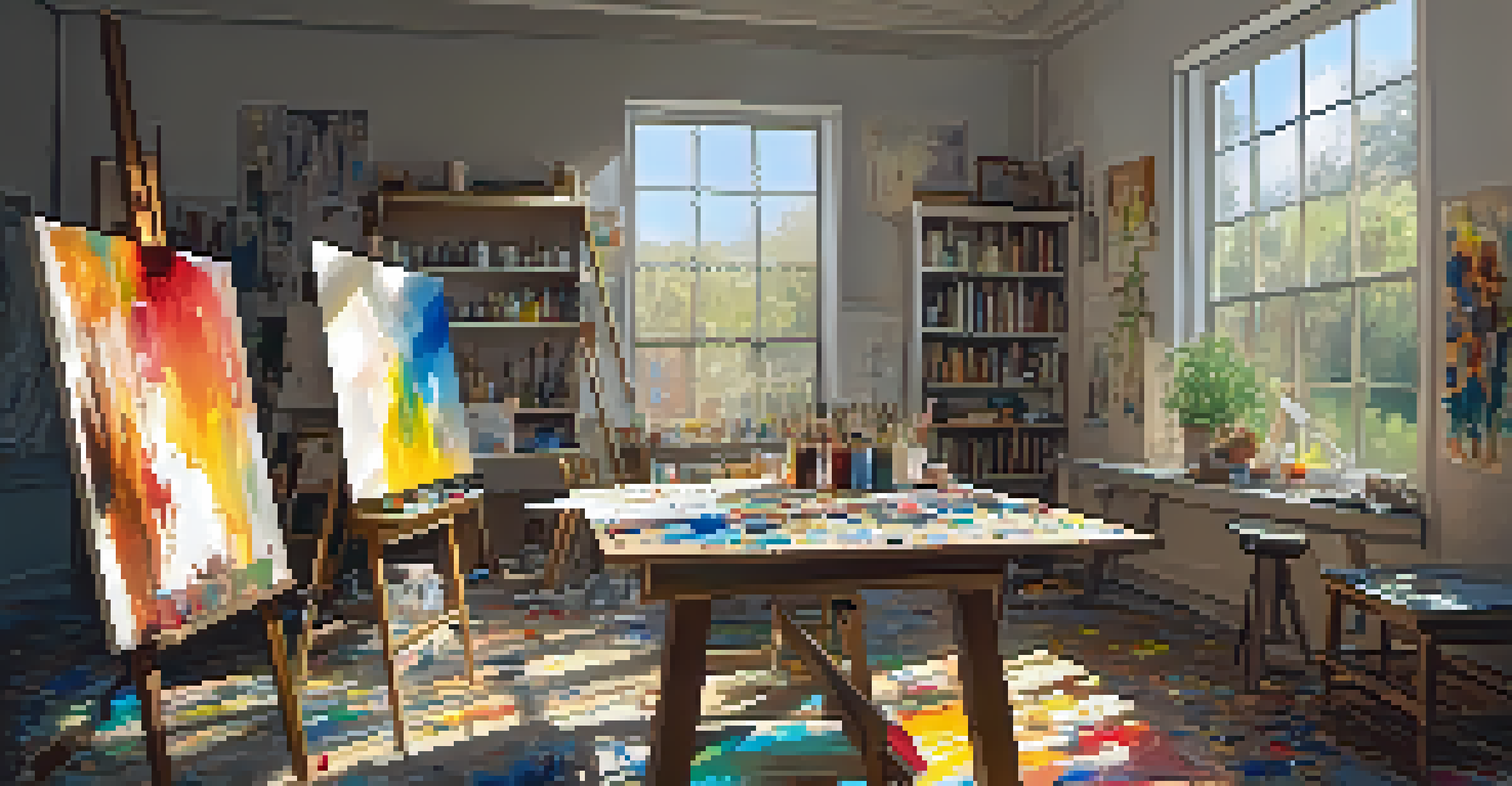Consumerism in Art Criticism: Analyzing Market Influences

Defining Consumerism in the Art World
Consumerism refers to the societal trend of purchasing goods and services, and in the art world, it plays a pivotal role. Artists often find themselves navigating a marketplace that values commercial success alongside artistic merit. This dual influence can create a tension between artistic integrity and the need for financial viability. By understanding this dynamic, we can better appreciate how consumerism shapes the art we see and critique.
Art is not a mirror held up to reality, but a hammer with which to shape it.
For example, an artist may feel pressured to create work that appeals to collectors rather than following their creative instincts. This situation can lead to a homogenization of styles, where unique voices get drowned out by market demands. Furthermore, the rise of social media has amplified these pressures, as artists often gauge their success through likes and shares, reflecting consumerist values.
Ultimately, recognizing consumerism's impact allows critics and audiences to engage with art more thoughtfully. It encourages us to ask questions about the motivations behind a piece, fostering a deeper appreciation for the artist's journey amidst market challenges.
The Role of Art Critics in a Consumerist Society
Art critics serve as the bridge between artists and the public, but their role is complex in a consumer-driven environment. Critics often evaluate art based on both aesthetic qualities and market trends, which can skew perceptions. This duality raises questions about whether critiques are influenced by the commercial success of a piece or if they truly reflect artistic value.

For instance, a critic might laud a popular artist’s work due to its marketability, even if it lacks originality. This scenario can lead to a cycle where emerging artists feel pressured to conform to mainstream tastes to gain recognition. Such dynamics can stifle innovation, as critics may prioritize market trends over authentic artistic expression.
Consumerism Shapes Artistic Integrity
The tension between commercial success and artistic merit often pressures artists to conform to market demands, impacting their creative expression.
By understanding the critic's role in this landscape, we can better navigate the art world. It highlights the importance of supporting critics who champion lesser-known artists and challenge consumerist norms, promoting a more diverse and vibrant artistic community.
Market Trends and Their Impact on Artistic Expression
Market trends significantly influence artistic expression, often dictating what is considered valuable or relevant. For example, the rise of digital art has transformed how artists create and sell their work, leading to new forms of expression that challenge traditional norms. However, this shift can also result in pressure to conform to what sells, impacting the authenticity of the art produced.
The greatest value of a picture is when it forces us to notice what we never expected to see.
Take, for instance, the trend of minimalism, which has gained immense popularity in recent years. While some artists embrace this style for its aesthetic appeal, others may feel compelled to adopt it simply because it aligns with current market preferences. This situation raises important questions about the relationship between artistic freedom and commercial viability.
Understanding the connection between market trends and artistic expression is crucial for both artists and critics. It encourages a dialogue about the importance of maintaining artistic integrity while navigating commercial pressures, ultimately enriching the art landscape.
The Collector's Influence on Art Criticism
Art collectors wield significant influence over the art market, and consequently, art criticism. Their preferences often shape what is deemed valuable, creating a feedback loop between collectors, artists, and critics. This relationship can lead to a prioritization of commercially viable works, overshadowing innovative or experimental pieces that lack market appeal.
For instance, a collector's endorsement of an emerging artist can catapult them into the spotlight, affecting how critics perceive their work. This phenomenon can create a narrow definition of success, where only those who meet specific market criteria are celebrated. Critics may feel pressured to align their evaluations with collector interests, potentially compromising their objectivity.
Critics Influence Market Perceptions
Art critics navigate a complex landscape where their evaluations can be swayed by market trends, potentially overshadowing authentic artistic voices.
Recognizing the collector's role in this ecosystem allows for a more nuanced understanding of art criticism. It highlights the need for critics to advocate for diverse artistic voices and challenge the status quo, ensuring that the art world remains inclusive and vibrant.
The Impact of Digital Platforms on Art Consumption
Digital platforms have revolutionized art consumption, making it more accessible than ever. Social media and online galleries allow artists to showcase their work to a global audience, but they also come with consumerist pressures. The need for engagement and visibility can lead artists to create work that prioritizes marketability over authenticity.
Consider the phenomenon of 'Instagram art,' where aesthetic appeal often trumps depth or originality. While these platforms can democratize art, they can also foster a culture where trends dictate value, overshadowing the artist's true vision. Critics must navigate this landscape carefully, balancing the recognition of popular art with an appreciation for more profound, less commercial works.
Understanding the dual nature of digital platforms is essential for both artists and critics. It encourages a more balanced approach to art consumption, where engagement does not compromise the integrity of artistic expression.
Examining Artistic Intent in a Market-Driven World
Artistic intent is often at the heart of an artist's work, but consumerism can complicate this narrative. When market forces become the primary motivator, the original message or intention behind a piece may get lost. This tension raises questions about the authenticity of art and the pressures artists face to cater to consumer demands.
For example, an artist may initially create a piece to express personal experiences, only to later alter it to appeal to buyers. This shift can dilute the emotional resonance of the work, transforming it into a product rather than a form of genuine expression. Critics play a vital role in highlighting these nuances, encouraging viewers to consider the implications of consumerism on artistic intent.
Digital Platforms Redefine Art Value
While digital platforms democratize art access, they also foster consumerist pressures that can compromise the authenticity of artistic expression.
By examining artistic intent within a market-driven context, we gain a deeper appreciation for the complexities of artistic creation. It prompts us to engage with art on a more profound level, fostering a dialogue about the balance between commercial success and authentic expression.
The Future of Art Criticism in a Consumerist Landscape
As the art world continues to evolve, the future of art criticism will likely reflect ongoing consumerist trends. Critics must adapt to new realities, including the rise of digital platforms and changing market dynamics. This evolution presents both challenges and opportunities for critics, who must find ways to remain relevant while fostering a diverse artistic landscape.
For instance, critics who embrace digital media can reach wider audiences, sharing insights that challenge consumer-driven narratives. By promoting underrepresented artists and questioning market trends, they can contribute to a more equitable art world. This approach not only enriches art criticism but also encourages artists to pursue their unique visions without succumbing to market pressures.

Ultimately, the future of art criticism lies in its ability to balance commercial realities with a commitment to artistic integrity. By fostering open dialogue and championing diverse voices, critics can play a pivotal role in shaping a vibrant and inclusive art community.